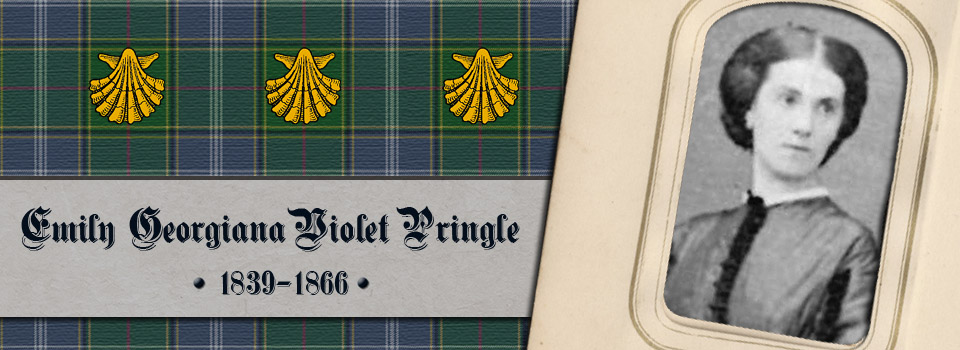Emily Georgiana Violet Pringle (1839 - 1866)
Emily was the second child and first daughter of John Pringle and Georgiana Ramsbottom, known to her family and friends as "Violet".
Violet was born in London just five days after Christmas of 1839, and she must have seemed like the perfect gift to the whole family, since she held the proud distinction of being the first Pringle granddaughter. Her baptism occurred four months later at St. George's in Bloomsbury, but much of her childhood was passed in France (particularly in Paris). As a senior officer in the Coldstream Guards (during a relatively peaceful time in British history), Violet's father had plenty of time to travel and a fondness for the Continent (where he and his family spent as many as six months of each year). They lived in many different places, and Violet and her siblings were as fluent in French as they were English. Claire Clairmont (a friend of Violet's parents) was always full of praises for the Pringle children, calling them "lovely and pretty . . . and so full of character — so clever and independent, but so soft and affectionate — not a jot will they yield if they are harshly treated, but will for kindness, or a kind look, do the most impossible tasks".
Surrounded by a very close and loving extended family, Violet lived with not only her parents and six siblings but also her maternal grandmother and aunt (they all appear together on the 1851 census, living in London at 13 Kensington Gardens). Six months before Violet's eighteenth birthday, befitting the daughter of a high-ranking Army officer of the time, she was presented to Queen Victoria at Her Majesty's Drawing Room of June 1857, beginning a span of several years spent circulating in London's high society, at parties and balls, in the company of her parents. In early 1860 (when Violet was just 20 years old), the family found a new home at 3 Queen's Gate Terrace in London, and Violet and her younger sisters were elected as Fellows of the London Horticultural Society. By this time, the Society was as much a symbol of social standing as it was a passion for horticulture (if, however, Violet and her sisters cared to enjoy a bit of gardening, they were entitled to the use of the Horticultural Society's special acreage set aside for the use of members). Finally, four years after her "coming out" and Court Presentation, 21-year-old Violet became engaged to marry Captain (later Colonel) John Peyton of the 18th Hussars. The groom being a Roman Catholic Irishman, the couple were actually married in two different ceremonies on 9 July 1861. The first ceremony took place at the Catholic Oratory in London, the second following at the Anglican St. Paul's in Knightsbridge.
Although John and Violet's marriage proved a rather short one (due to her early death), they were together long enough to have been blessed with three children. The first two sons were born in England, but the Captain was stationed in India at the time of her lying-in for their third son. By 1866, the family were living together in Wellington (Madras), where she gave birth to her third son on the seventh of May. Sadly, she never left her confinement bed, where – at the young age of 26 years, just 12 days after the birth of William – Violet Peyton died of fever.
Violet was buried, in the churchyard of All Saints in Coonoor, the day after she died (as was customary in the hot clime of India). A tombstone with the following inscription was erected over her grave:
To the Beloved Memory of Violet,
Wife of Captain Peyton, 18th Hussars,
and Daughter of Colonel Pringle,
Late Coldstream Guards,
died at Wellington,
May 19th, 1866, aged 26.

The news of Violet's death did not reach the London papers for almost two months, and the grief of her parents can only be imagined. Her two oldest sons were sent off to live with friends in Italy, and it was many years before any of them returned to England and renewed relationships with their mother's family. So far, only one small photograph of Violet (taken in England in the 1860s) has surfaced, saved by her youngest sister. Blanche not only saved this small memento of her older sister, but she also named her only daughter "Eleanor Violet", after both of her older sisters.


